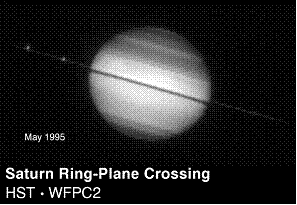Shadow Transits on Saturn
Jack Kramer
Saturn presents us with an observing challenge this year. As you know, the rings change orientation as seen from Earth, and about every fifteen years the rings appear edge-on. That's due to the tilt of Saturn's equator with respect to its orbital plane and the inclination of its orbit to the ecliptic. In early September 2009 the rings will again be exactly edge-on. While the edge-on appearance of the rings is a novel situation, many observers will be looking forward to a more open appearance of the rings so they can be seen in all their glory. However, the observing challenge at this time is not the rings, but something else that we don't often see.
Saturn's inner moons have orbits that are inclined the same as the rings, so the shadows of the satellites generally miss the ball of the planet as seen from Earth. But, just as is the case of shadow transits of Jupiter's moons, transits of Saturn's moons can be seen, but only during the roughly four year period centered on when Saturn's rings appear edge-on. Because Saturn is more remote than Jupiter, it's not as easy to see the shadow transits. However, Titan's shadow has been detected with telescopes as small as about 3 inches and the shadow of Rhea has been seen with a scope of 61/2 inches. Saturn is well placed during evening hours this spring and early summer.
 The Hubble image here shows Saturn at its last edge-on aspect back in 1995, and you'll notice two satellites lying in the same plane as the ring system. So if you have a computer program that shows the positions of the satellites, be especially watchful around the time when one of the larger moons is transiting. Meridian is a very useful freeware program that includes Saturn's moons:
http://www.merid.cam.org/meridian/index.html
Published in the April 2009 issue of the NightTimes
The Hubble image here shows Saturn at its last edge-on aspect back in 1995, and you'll notice two satellites lying in the same plane as the ring system. So if you have a computer program that shows the positions of the satellites, be especially watchful around the time when one of the larger moons is transiting. Meridian is a very useful freeware program that includes Saturn's moons:
http://www.merid.cam.org/meridian/index.html
Published in the April 2009 issue of the NightTimes





